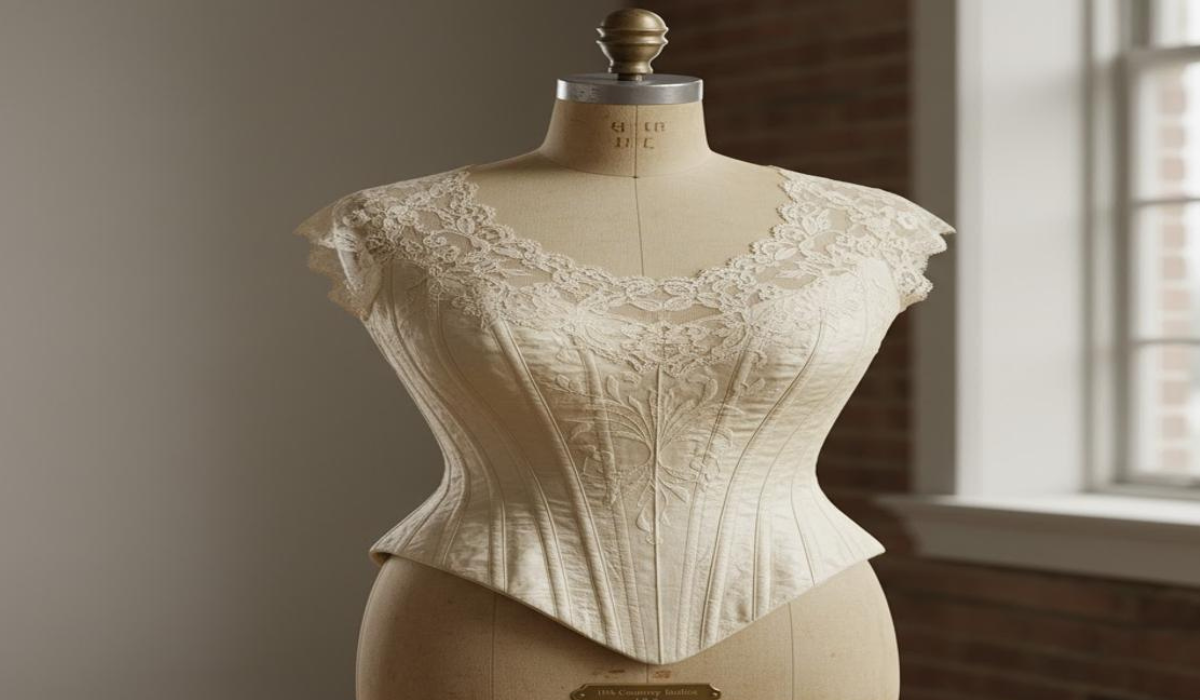The bodice is one of the most fascinating and enduring components in the history of clothing design. Found at the intersection of function, art, and identity, the bodice has evolved from a rigid, restrictive garment into a versatile and expressive part of fashion. Whether it’s in historical dresses, bridal gowns, or modern couture, the bodice tells a story one that reveals not just how people dressed, but how they lived, moved, and viewed themselves through time.
This article explores the origins, structure, evolution, and cultural importance of the bodice, shedding light on why this single piece of clothing remains so central to the human experience of dress.
1. What is a Bodice?
In the simplest definition, a bodice refers to the part of a woman’s garment that covers the torso, extending from the neck or shoulders to the waist. It is typically fitted and can either be a separate piece or attached to a skirt, forming a dress. Historically, the bodice has been designed to shape the body — emphasizing the bust and waist — and to provide structural support.
The bodice serves both aesthetic and practical functions. It not only enhances the silhouette but also influences posture, movement, and the overall impression of the outfit. Depending on the era, it could be stiffened with boning, lined with linen, or decorated with embroidery, reflecting both fashion trends and social values of the time.
2. The Origins of the Bodice
The origins of the bodice can be traced back to the 15th century, when fitted garments began replacing the loose robes of earlier medieval fashion. As tailoring techniques advanced, clothing began to follow the natural contours of the body more closely.
In the Renaissance period, the bodice became a distinct and prominent feature of women’s fashion. Often reinforced with whalebone or wood, it helped create the idealized hourglass figure of the era. The laced front or back allowed for adjustment, making it both a fashion statement and a symbol of refinement.
During this time, bodices were often detachable, meaning they could be worn with different skirts. This flexibility allowed women to mix and match elements of their wardrobe — a practical approach long before the rise of modern separates.
3. The Bodice Through the Centuries
The 16th and 17th Centuries: Structure and Symbolism
By the 1500s, the bodice was a symbol of status and propriety. The stiffer the structure, the higher the social rank it signified. Women of the upper classes wore bodices with intricate embroidery, jewels, and luxurious fabrics such as velvet and brocade. Working women, meanwhile, wore simpler, more practical versions made of wool or linen.
The Elizabethan bodice featured pointed waists and broad shoulders, creating the illusion of a longer torso. Corsetry became an integral part of this structure, with the bodice serving as both an external decoration and an internal frame.
The 18th Century: Elegance and Extravagance
In the 18th century, bodices evolved with the elaborate court fashions of Europe. The stays, a tightly laced undergarment, were often considered part of the bodice itself. They created a rigid, conical shape that pushed the bust upward and cinched the waist tightly. The outer bodice was adorned with lace, ribbons, and embroidery — a celebration of femininity and luxury.
However, not all bodices were purely ornamental. In rural and working-class communities, simpler bodices provided comfort and ease of movement, made from cotton or linen and designed for practicality rather than grandeur.
The 19th Century: The Rise of the Dress Bodice
As the Industrial Revolution changed manufacturing, dressmaking became more accessible, and the bodice underwent another transformation. The Victorian era saw a focus on modesty and propriety. Bodices were often high-necked and long-sleeved, sometimes extending over the hips in elaborate designs. The invention of the sewing machine made it easier to produce fitted garments with precision, and patterns became widely available to the public.
Later in the 19th century, the bodice became more natural in shape, with less rigid boning and more emphasis on comfort. The Edwardian era favored the “S-curve” silhouette — a softer, more romantic look achieved through less severe corsetry.
The 20th Century: Redefinition and Freedom
The 20th century brought radical changes in women’s clothing, and the bodice reflected this evolution. The 1920s saw a rejection of tight-fitting garments, with looser, dropped-waist styles. However, by the mid-century, the bodice returned in more flexible and expressive forms.
Designers like Christian Dior, with his famous “New Look” of the late 1940s, revived the fitted bodice paired with a voluminous skirt, celebrating femininity in a postwar world.
By the 1980s and beyond, the bodice had taken on new meanings — sometimes as a nod to historical fashion, sometimes as a symbol of empowerment and individuality. Today, it appears in bridal couture, high fashion, and even everyday clothing in subtle forms.
4. Types of Bodices
While the term “bodice” often conjures images of historical gowns, there are several modern variations, including:
- Corseted Bodice – A tightly fitted style using boning or structured seams to define the waist.
- Bustier Bodice – A shorter, often strapless bodice that extends just below the bust, emphasizing shape.
- Peplum Bodice – Features a flared extension at the waist, adding a decorative and flattering touch.
- Princess Seam Bodice – Uses vertical seams to follow the body’s natural curves without a waistline seam.
- Off-Shoulder Bodice – Exposes the shoulders and neckline, often used in evening or bridal wear.
These variations reflect the bodice’s adaptability — a design element that continues to evolve with changing aesthetics.
5. Construction and Design Elements
Constructing a bodice requires precision and understanding of body proportions. Tailors and designers consider several aspects:
- Darts and Seams: These provide shape and contour to the garment.
- Boning: Thin strips of plastic or metal that add structure.
- Lining: Improves comfort and maintains form.
- Closures: Hooks, buttons, zippers, or laces allow for adjustment and fit.
- Fabric Choice: Stiff fabrics like taffeta create structure, while softer materials like silk or satin produce a flowing, romantic effect.
Each design choice communicates something — from elegance to strength — making the bodice a true storytelling tool in fashion.
6. The Bodice in Modern Fashion
In contemporary fashion, the bodice continues to inspire designers and consumers alike. Its form-fitting silhouette aligns perfectly with today’s appreciation for tailored elegance and individuality. Bodice-inspired tops, dresses, and corsets are frequently seen on red carpets, runways, and social media platforms.
Modern bodices no longer symbolize restraint or formality; instead, they represent empowerment and expression. Designers reimagine them with sustainable fabrics, minimalist cuts, and gender-inclusive designs. The bodice has transcended its origins to become a symbol of self-definition.
7. Cultural and Artistic Significance
Beyond fashion, the bodice has influenced art, literature, and performance. Paintings from the Renaissance to the Romantic era often used the bodice as a visual metaphor — representing beauty, virtue, or societal expectation. In theater and film, bodices help transport audiences to different eras, shaping both character and mood.
Culturally, bodices have carried different meanings across regions. In some traditional European costumes, like the Austrian dirndl or the Bavarian tracht, the bodice remains an integral part of national identity and heritage.
8. The Enduring Legacy of the Bodice
Despite centuries of change, the bodice continues to symbolize craftsmanship, femininity, and evolution. It reflects how fashion moves — from restriction to liberation, from uniformity to personal expression. Today, the bodice stands not as a relic of the past, but as a living piece of art — reinterpreted with every generation that wears it.
Informational FAQs about the Bodice
Q1: What is the difference between a bodice and a corset?
A bodice is the upper part of a garment that covers the torso and may be decorative or structural. A corset is typically an undergarment designed specifically to shape the waist and torso tightly. While some bodices incorporate corset elements, not all bodices are corsets.
Q2: How were historical bodices fastened?
Historical bodices were often fastened using laces, hooks, or eyelets. Some had front or back openings, allowing for adjustable tightness.
Q3: Are bodices still worn today?
Yes, modern fashion frequently uses bodice-style tops, dresses, and corsets in both casual and formal wear. They are especially popular in bridal and couture fashion.
Q4: What materials are commonly used for making bodices?
Traditional bodices used linen, silk, or velvet with stiffeners like whalebone. Modern bodices may use satin, lace, polyester blends, or even stretch fabrics for comfort and versatility.
Q5: What does the bodice symbolize in fashion history?
The bodice often symbolizes femininity, discipline, and beauty. Over time, it has evolved into a symbol of self-expression and empowerment.

